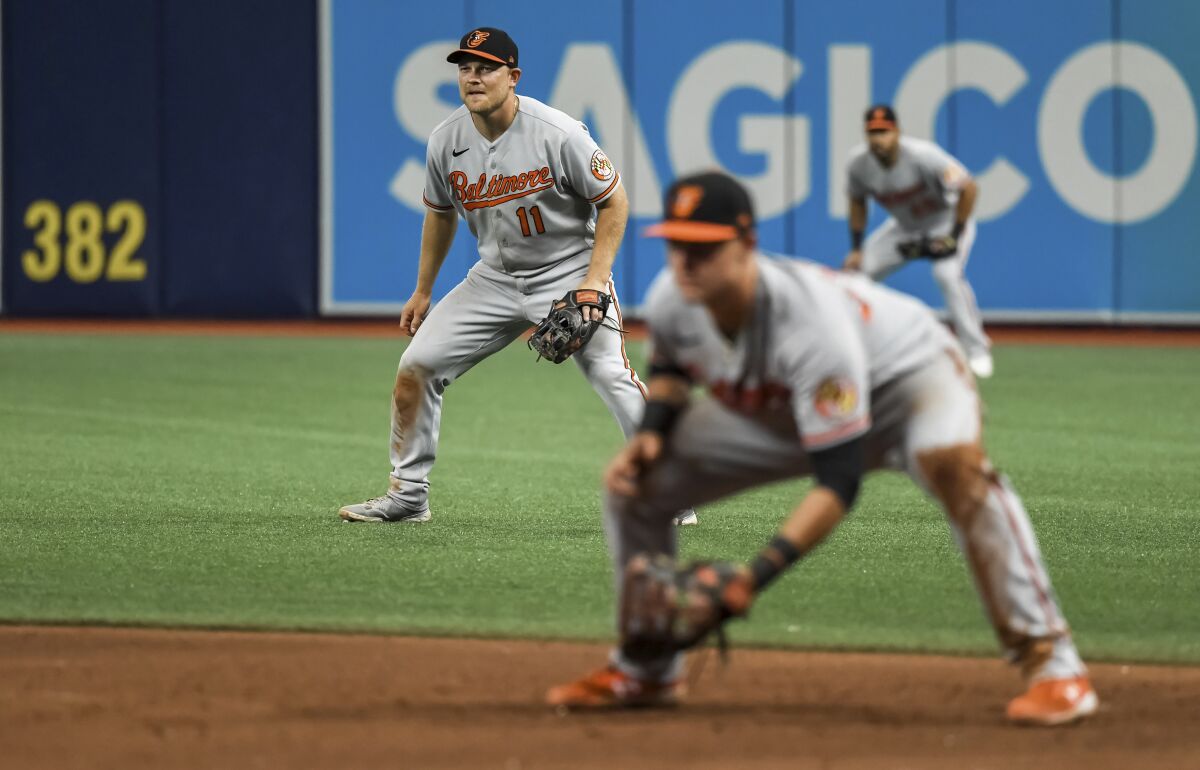
Baltimore Orioles infielder Pat Valaika (11) sets for a defensive shift during a game against the Tampa Bay Rays in July 2021.
(Steve Nesius / Associated Press)
This rule change will be the most obvious to the eye. Drastic infield shifts have become so common across the majors over the last decade that it’s been more noteworthy when an infield doesn’t shift. We’ve seen four outfielders. We’ve seen two outfielders. We’ve seen the third baseman stationed in shallow right field against most left-handed hitters. And we’ve seen San Diego Padres third baseman Manny Machado positioned 200 feet from home plate in right field multiple times.
Anti-shifters contend the trend helped create the three-true-outcome plague (home run, walk or strikeout) that has hindered game action. They also argue it created a disadvantage for left-handed hitters, converting groundballs to the right side and line drives to shallow right field into outs. The anti anti-shifters believe it’s on the hitters to adjust, that the sport goes through cycles.
MLB decided forced change was required after watching the batting average on balls in play (BABIP) drop six points from 2012 to 2022 and strikeouts skyrocket. So, starting next season, the defense must have at least four players on the infield and at least two infielders entirely on either side of second base. The penalty is an automatic ball.
“Left-handed hitters will undoubtedly benefit,” an American League executive said. “But how much? Is that two extra hits a month for Bryce Harper? Five? Does his OPS [on-base-plus-slugging percentage] increase 10 points? Twenty points? It’s tough to project.”
One National League executive pointed to the Pittsburgh Pirates signing first baseman Carlos Santana to a one-year, $6.7-million contract as an example of a club forecasting an effect.
Santana, a switch-hitter, had the same hard-hit rate last season as Mookie Betts but batted .192 with a .692 OPS and a 100 OPS+ (meaning he was a league-average hitter) with 364 plate appearances hitting left-handed. Betts finished with a .269 batting average, .873 OPS and 136 OPS+ (meaning he was 36% better than the average hitter).
“That might one of the best signings, value-wise, of the offseason,” the executive said.
This rule doesn’t eliminate the infield shift; teams are still going to put an infielder up the middle, just to the left of second base, with the second baseman over in the hole against left-handed hitters.
“You’ll see the second baseman way over, but you can’t go out and get that short line drive to right,” Cleveland Guardians manager Terry Francona said. “I just hope that it doesn’t encourage bad hitting. I hope that the unintended consequences don’t leak in where guys are really trying to pull now, and you see more strikeouts.”
In regards to roster construction, several managers and executives said range from their middle infielders, especially second basemen, will become more important. Theoretically, teams could become more reluctant to put a bat-first defensive liability at second base.
“As far as the defensive shifting, we want to create a very athletic infield that can cover ground,” Arizona Diamondbacks manager Torey Lovullo said. “I already have asked our guys to go in and prepare themselves from the waist down if you’re an infielder because you’re going to have to go out and get the job done on a much bigger scale.
“It’s going to create a lot more offense. There’s going to be a lot of gaps in the defense. We’re still going to plug holes the best way we can, but we’re only going to do it with two guys.”
Stay connected with us on social media platform for instant update click here to join our Twitter, & Facebook
We are now on Telegram. Click here to join our channel (@TechiUpdate) and stay updated with the latest Technology headlines.
For all the latest Hollywood News Click Here
